Falls Hazards in the Construction Industry
VerifiedAdded on 2023/06/03
|13
|3367
|274
AI Summary
This paper examines fall hazards in the construction industry, which have resulted in more fatalities than any other sector. It identifies the various fall hazards, establishes comparisons, and draws conclusions and recommendations to reduce fall hazards and create awareness. The causes of fall hazards are discussed, and control measures and recommendations are provided.
Contribute Materials
Your contribution can guide someone’s learning journey. Share your
documents today.
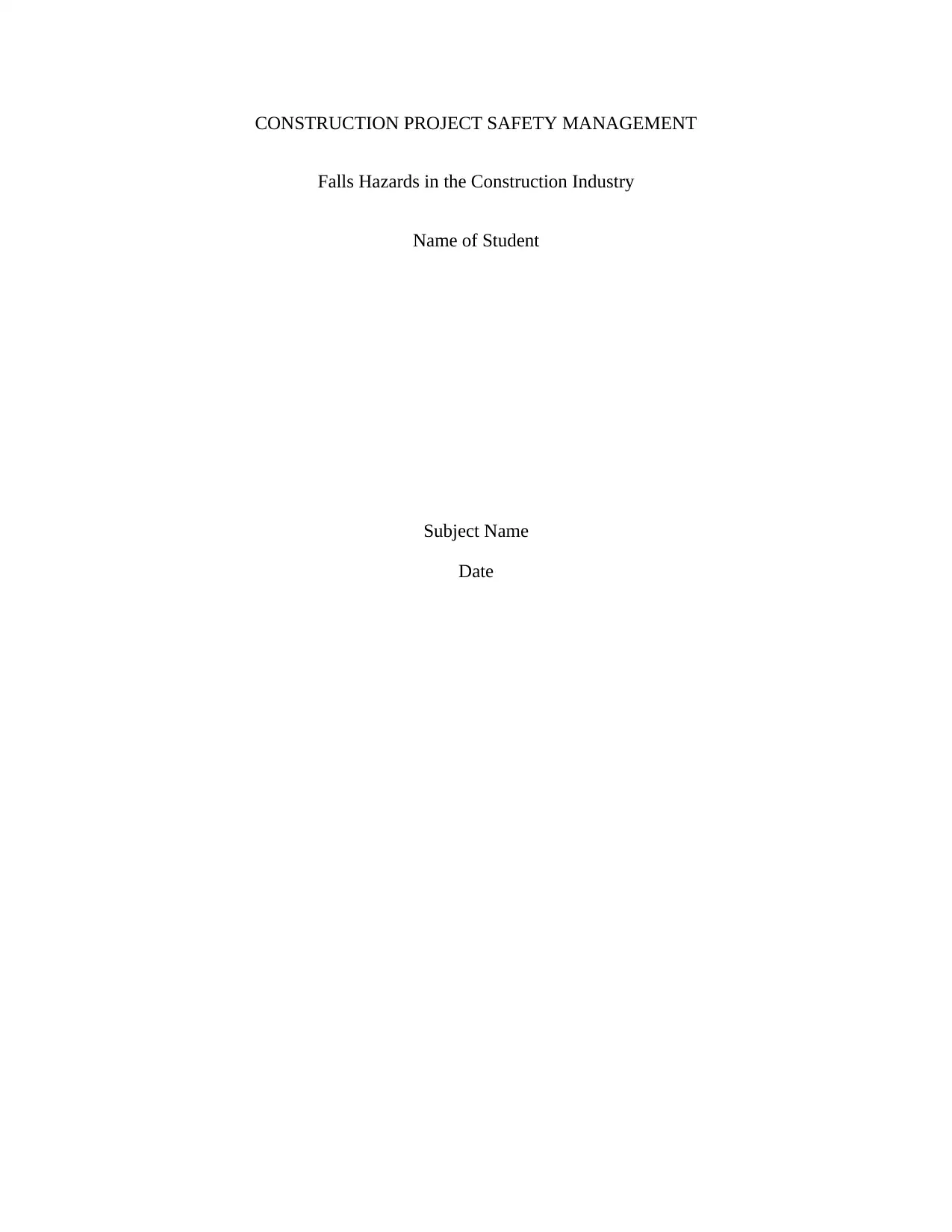
CONSTRUCTION PROJECT SAFETY MANAGEMENT
Falls Hazards in the Construction Industry
Name of Student
Subject Name
Date
Falls Hazards in the Construction Industry
Name of Student
Subject Name
Date
Secure Best Marks with AI Grader
Need help grading? Try our AI Grader for instant feedback on your assignments.
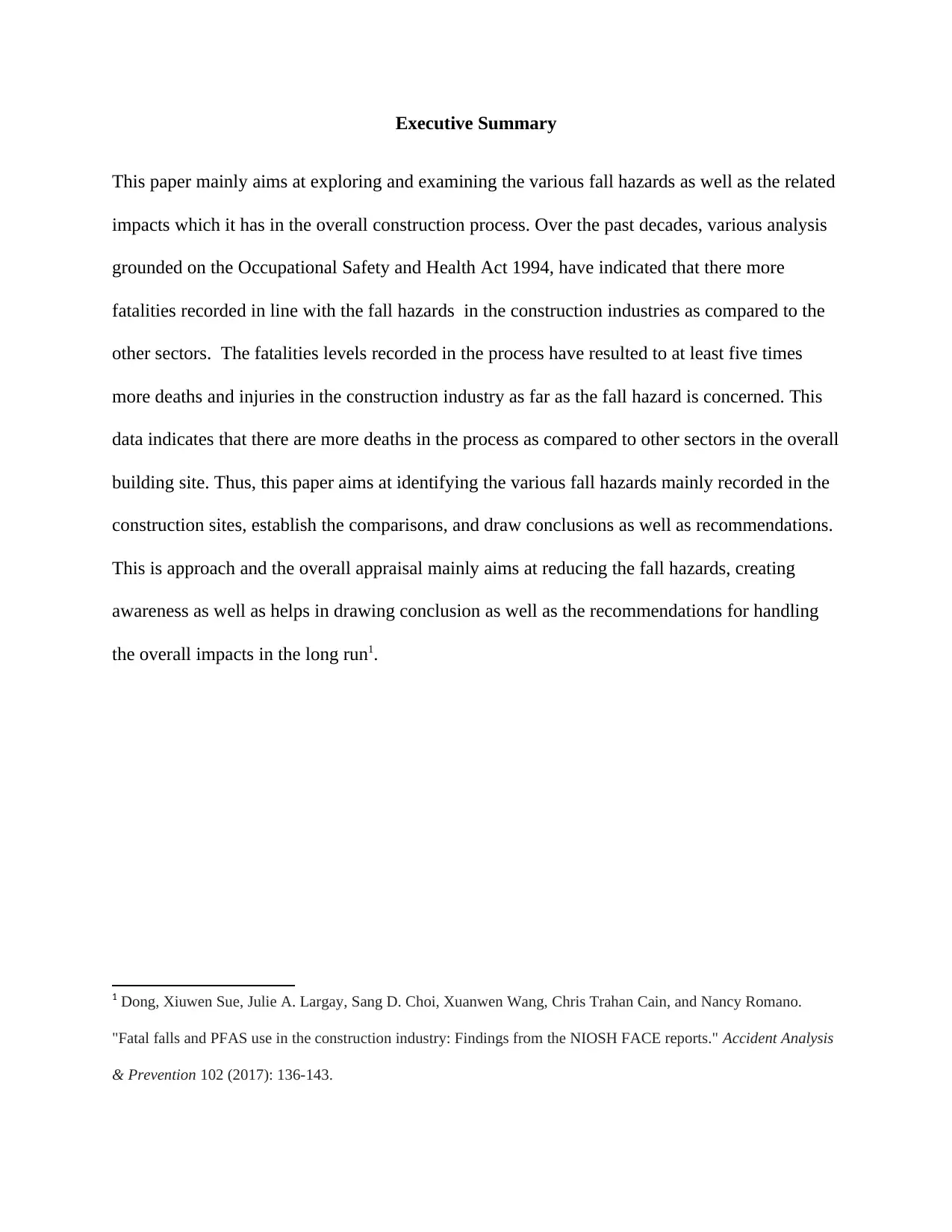
Executive Summary
This paper mainly aims at exploring and examining the various fall hazards as well as the related
impacts which it has in the overall construction process. Over the past decades, various analysis
grounded on the Occupational Safety and Health Act 1994, have indicated that there more
fatalities recorded in line with the fall hazards in the construction industries as compared to the
other sectors. The fatalities levels recorded in the process have resulted to at least five times
more deaths and injuries in the construction industry as far as the fall hazard is concerned. This
data indicates that there are more deaths in the process as compared to other sectors in the overall
building site. Thus, this paper aims at identifying the various fall hazards mainly recorded in the
construction sites, establish the comparisons, and draw conclusions as well as recommendations.
This is approach and the overall appraisal mainly aims at reducing the fall hazards, creating
awareness as well as helps in drawing conclusion as well as the recommendations for handling
the overall impacts in the long run1.
1 Dong, Xiuwen Sue, Julie A. Largay, Sang D. Choi, Xuanwen Wang, Chris Trahan Cain, and Nancy Romano.
"Fatal falls and PFAS use in the construction industry: Findings from the NIOSH FACE reports." Accident Analysis
& Prevention 102 (2017): 136-143.
This paper mainly aims at exploring and examining the various fall hazards as well as the related
impacts which it has in the overall construction process. Over the past decades, various analysis
grounded on the Occupational Safety and Health Act 1994, have indicated that there more
fatalities recorded in line with the fall hazards in the construction industries as compared to the
other sectors. The fatalities levels recorded in the process have resulted to at least five times
more deaths and injuries in the construction industry as far as the fall hazard is concerned. This
data indicates that there are more deaths in the process as compared to other sectors in the overall
building site. Thus, this paper aims at identifying the various fall hazards mainly recorded in the
construction sites, establish the comparisons, and draw conclusions as well as recommendations.
This is approach and the overall appraisal mainly aims at reducing the fall hazards, creating
awareness as well as helps in drawing conclusion as well as the recommendations for handling
the overall impacts in the long run1.
1 Dong, Xiuwen Sue, Julie A. Largay, Sang D. Choi, Xuanwen Wang, Chris Trahan Cain, and Nancy Romano.
"Fatal falls and PFAS use in the construction industry: Findings from the NIOSH FACE reports." Accident Analysis
& Prevention 102 (2017): 136-143.
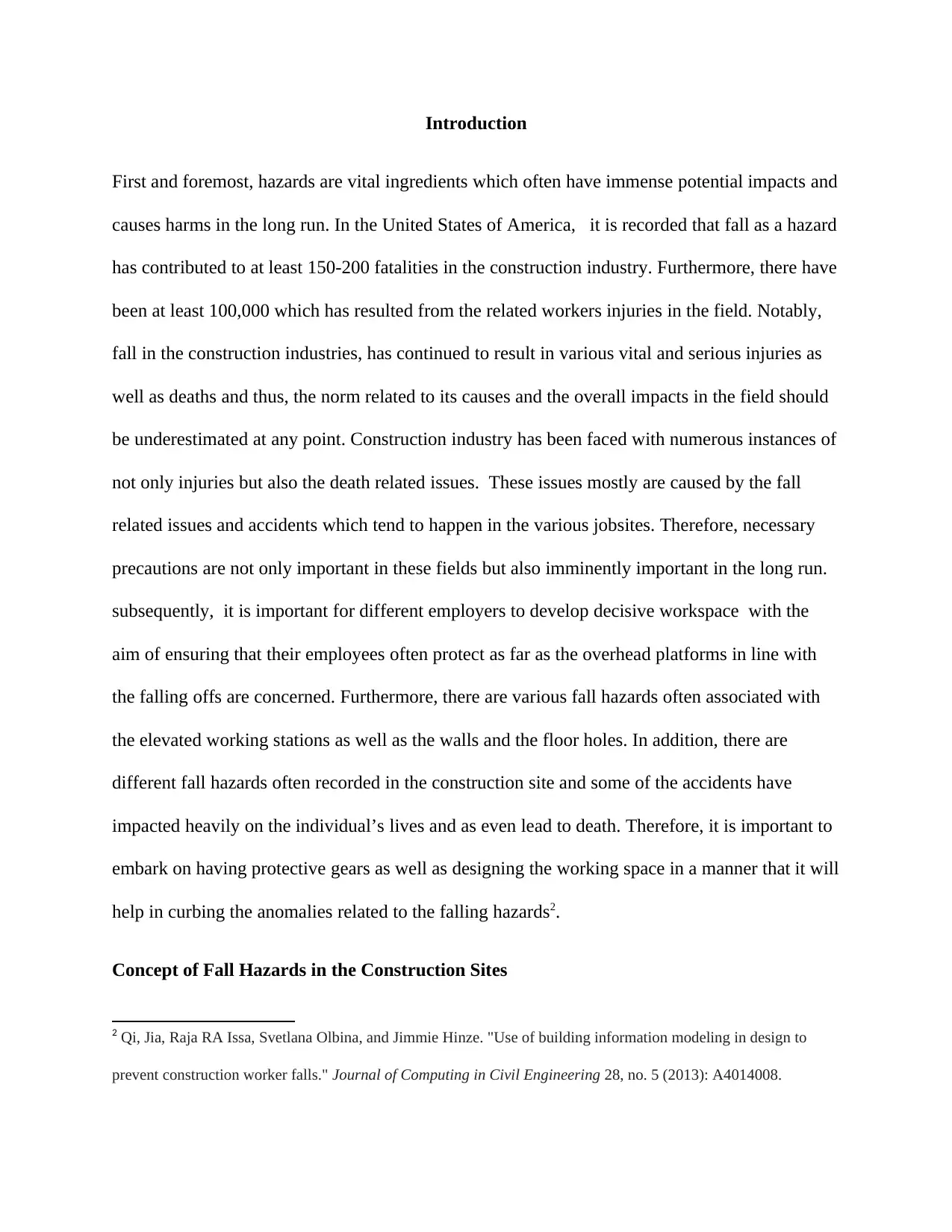
Introduction
First and foremost, hazards are vital ingredients which often have immense potential impacts and
causes harms in the long run. In the United States of America, it is recorded that fall as a hazard
has contributed to at least 150-200 fatalities in the construction industry. Furthermore, there have
been at least 100,000 which has resulted from the related workers injuries in the field. Notably,
fall in the construction industries, has continued to result in various vital and serious injuries as
well as deaths and thus, the norm related to its causes and the overall impacts in the field should
be underestimated at any point. Construction industry has been faced with numerous instances of
not only injuries but also the death related issues. These issues mostly are caused by the fall
related issues and accidents which tend to happen in the various jobsites. Therefore, necessary
precautions are not only important in these fields but also imminently important in the long run.
subsequently, it is important for different employers to develop decisive workspace with the
aim of ensuring that their employees often protect as far as the overhead platforms in line with
the falling offs are concerned. Furthermore, there are various fall hazards often associated with
the elevated working stations as well as the walls and the floor holes. In addition, there are
different fall hazards often recorded in the construction site and some of the accidents have
impacted heavily on the individual’s lives and as even lead to death. Therefore, it is important to
embark on having protective gears as well as designing the working space in a manner that it will
help in curbing the anomalies related to the falling hazards2.
Concept of Fall Hazards in the Construction Sites
2 Qi, Jia, Raja RA Issa, Svetlana Olbina, and Jimmie Hinze. "Use of building information modeling in design to
prevent construction worker falls." Journal of Computing in Civil Engineering 28, no. 5 (2013): A4014008.
First and foremost, hazards are vital ingredients which often have immense potential impacts and
causes harms in the long run. In the United States of America, it is recorded that fall as a hazard
has contributed to at least 150-200 fatalities in the construction industry. Furthermore, there have
been at least 100,000 which has resulted from the related workers injuries in the field. Notably,
fall in the construction industries, has continued to result in various vital and serious injuries as
well as deaths and thus, the norm related to its causes and the overall impacts in the field should
be underestimated at any point. Construction industry has been faced with numerous instances of
not only injuries but also the death related issues. These issues mostly are caused by the fall
related issues and accidents which tend to happen in the various jobsites. Therefore, necessary
precautions are not only important in these fields but also imminently important in the long run.
subsequently, it is important for different employers to develop decisive workspace with the
aim of ensuring that their employees often protect as far as the overhead platforms in line with
the falling offs are concerned. Furthermore, there are various fall hazards often associated with
the elevated working stations as well as the walls and the floor holes. In addition, there are
different fall hazards often recorded in the construction site and some of the accidents have
impacted heavily on the individual’s lives and as even lead to death. Therefore, it is important to
embark on having protective gears as well as designing the working space in a manner that it will
help in curbing the anomalies related to the falling hazards2.
Concept of Fall Hazards in the Construction Sites
2 Qi, Jia, Raja RA Issa, Svetlana Olbina, and Jimmie Hinze. "Use of building information modeling in design to
prevent construction worker falls." Journal of Computing in Civil Engineering 28, no. 5 (2013): A4014008.
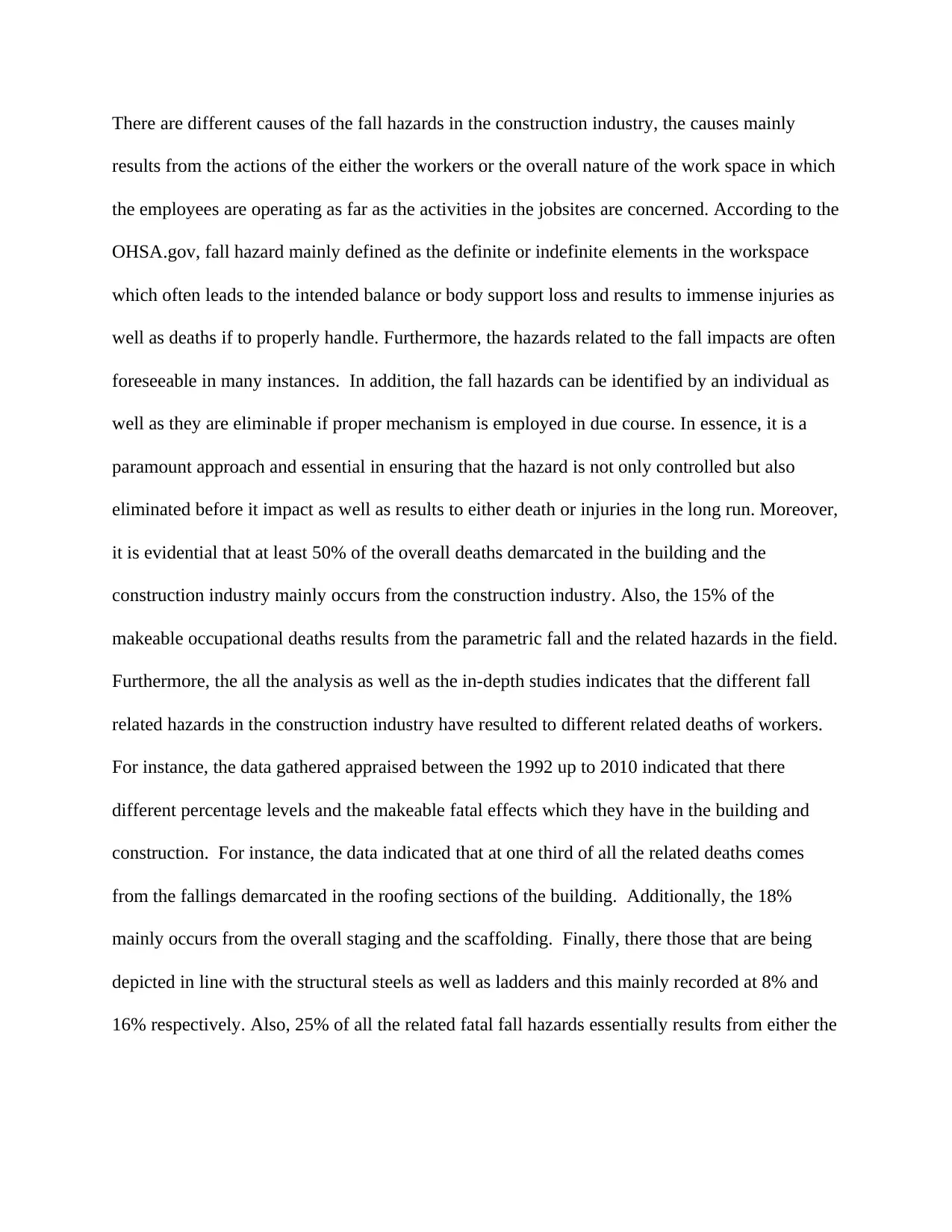
There are different causes of the fall hazards in the construction industry, the causes mainly
results from the actions of the either the workers or the overall nature of the work space in which
the employees are operating as far as the activities in the jobsites are concerned. According to the
OHSA.gov, fall hazard mainly defined as the definite or indefinite elements in the workspace
which often leads to the intended balance or body support loss and results to immense injuries as
well as deaths if to properly handle. Furthermore, the hazards related to the fall impacts are often
foreseeable in many instances. In addition, the fall hazards can be identified by an individual as
well as they are eliminable if proper mechanism is employed in due course. In essence, it is a
paramount approach and essential in ensuring that the hazard is not only controlled but also
eliminated before it impact as well as results to either death or injuries in the long run. Moreover,
it is evidential that at least 50% of the overall deaths demarcated in the building and the
construction industry mainly occurs from the construction industry. Also, the 15% of the
makeable occupational deaths results from the parametric fall and the related hazards in the field.
Furthermore, the all the analysis as well as the in-depth studies indicates that the different fall
related hazards in the construction industry have resulted to different related deaths of workers.
For instance, the data gathered appraised between the 1992 up to 2010 indicated that there
different percentage levels and the makeable fatal effects which they have in the building and
construction. For instance, the data indicated that at one third of all the related deaths comes
from the fallings demarcated in the roofing sections of the building. Additionally, the 18%
mainly occurs from the overall staging and the scaffolding. Finally, there those that are being
depicted in line with the structural steels as well as ladders and this mainly recorded at 8% and
16% respectively. Also, 25% of all the related fatal fall hazards essentially results from either the
results from the actions of the either the workers or the overall nature of the work space in which
the employees are operating as far as the activities in the jobsites are concerned. According to the
OHSA.gov, fall hazard mainly defined as the definite or indefinite elements in the workspace
which often leads to the intended balance or body support loss and results to immense injuries as
well as deaths if to properly handle. Furthermore, the hazards related to the fall impacts are often
foreseeable in many instances. In addition, the fall hazards can be identified by an individual as
well as they are eliminable if proper mechanism is employed in due course. In essence, it is a
paramount approach and essential in ensuring that the hazard is not only controlled but also
eliminated before it impact as well as results to either death or injuries in the long run. Moreover,
it is evidential that at least 50% of the overall deaths demarcated in the building and the
construction industry mainly occurs from the construction industry. Also, the 15% of the
makeable occupational deaths results from the parametric fall and the related hazards in the field.
Furthermore, the all the analysis as well as the in-depth studies indicates that the different fall
related hazards in the construction industry have resulted to different related deaths of workers.
For instance, the data gathered appraised between the 1992 up to 2010 indicated that there
different percentage levels and the makeable fatal effects which they have in the building and
construction. For instance, the data indicated that at one third of all the related deaths comes
from the fallings demarcated in the roofing sections of the building. Additionally, the 18%
mainly occurs from the overall staging and the scaffolding. Finally, there those that are being
depicted in line with the structural steels as well as ladders and this mainly recorded at 8% and
16% respectively. Also, 25% of all the related fatal fall hazards essentially results from either the
Secure Best Marks with AI Grader
Need help grading? Try our AI Grader for instant feedback on your assignments.
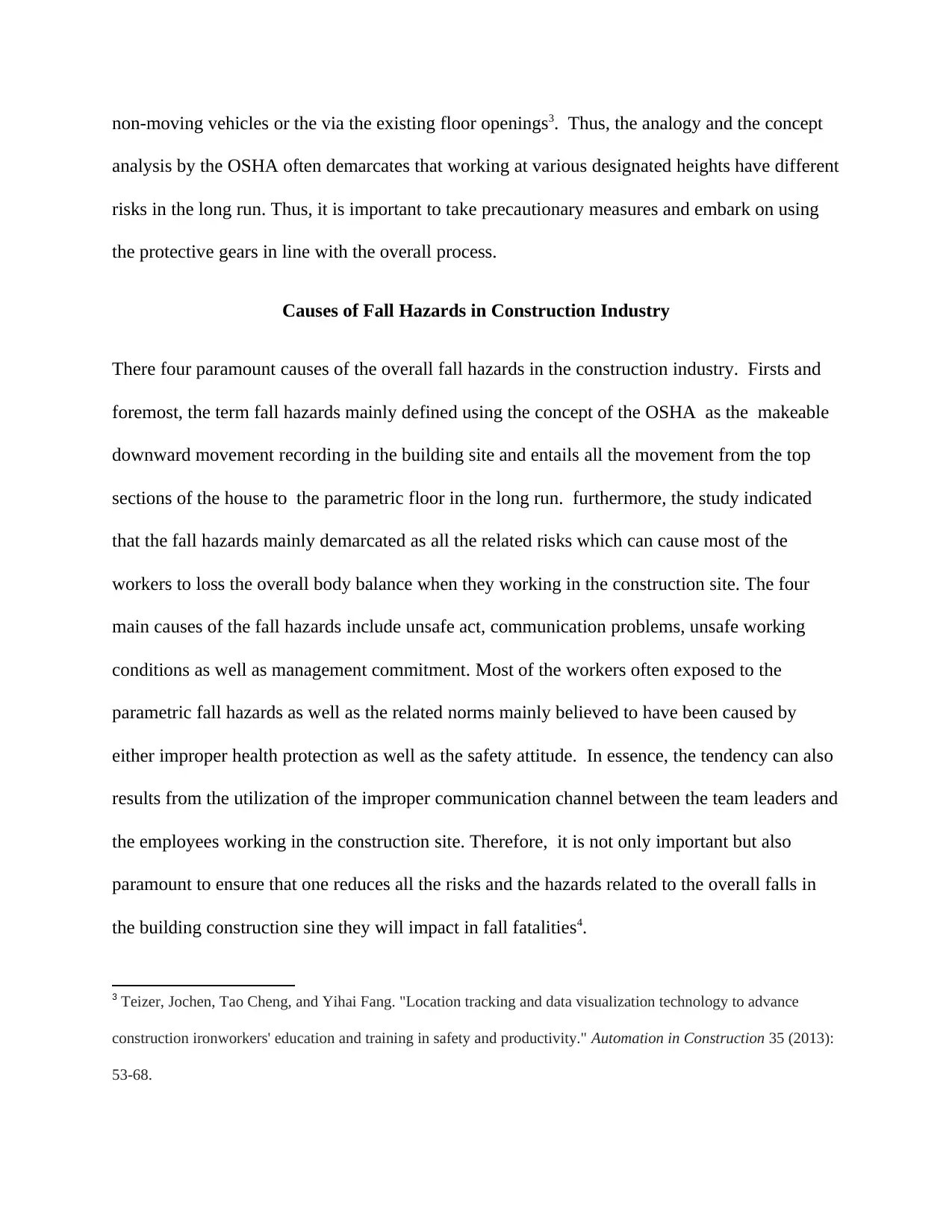
non-moving vehicles or the via the existing floor openings3. Thus, the analogy and the concept
analysis by the OSHA often demarcates that working at various designated heights have different
risks in the long run. Thus, it is important to take precautionary measures and embark on using
the protective gears in line with the overall process.
Causes of Fall Hazards in Construction Industry
There four paramount causes of the overall fall hazards in the construction industry. Firsts and
foremost, the term fall hazards mainly defined using the concept of the OSHA as the makeable
downward movement recording in the building site and entails all the movement from the top
sections of the house to the parametric floor in the long run. furthermore, the study indicated
that the fall hazards mainly demarcated as all the related risks which can cause most of the
workers to loss the overall body balance when they working in the construction site. The four
main causes of the fall hazards include unsafe act, communication problems, unsafe working
conditions as well as management commitment. Most of the workers often exposed to the
parametric fall hazards as well as the related norms mainly believed to have been caused by
either improper health protection as well as the safety attitude. In essence, the tendency can also
results from the utilization of the improper communication channel between the team leaders and
the employees working in the construction site. Therefore, it is not only important but also
paramount to ensure that one reduces all the risks and the hazards related to the overall falls in
the building construction sine they will impact in fall fatalities4.
3 Teizer, Jochen, Tao Cheng, and Yihai Fang. "Location tracking and data visualization technology to advance
construction ironworkers' education and training in safety and productivity." Automation in Construction 35 (2013):
53-68.
analysis by the OSHA often demarcates that working at various designated heights have different
risks in the long run. Thus, it is important to take precautionary measures and embark on using
the protective gears in line with the overall process.
Causes of Fall Hazards in Construction Industry
There four paramount causes of the overall fall hazards in the construction industry. Firsts and
foremost, the term fall hazards mainly defined using the concept of the OSHA as the makeable
downward movement recording in the building site and entails all the movement from the top
sections of the house to the parametric floor in the long run. furthermore, the study indicated
that the fall hazards mainly demarcated as all the related risks which can cause most of the
workers to loss the overall body balance when they working in the construction site. The four
main causes of the fall hazards include unsafe act, communication problems, unsafe working
conditions as well as management commitment. Most of the workers often exposed to the
parametric fall hazards as well as the related norms mainly believed to have been caused by
either improper health protection as well as the safety attitude. In essence, the tendency can also
results from the utilization of the improper communication channel between the team leaders and
the employees working in the construction site. Therefore, it is not only important but also
paramount to ensure that one reduces all the risks and the hazards related to the overall falls in
the building construction sine they will impact in fall fatalities4.
3 Teizer, Jochen, Tao Cheng, and Yihai Fang. "Location tracking and data visualization technology to advance
construction ironworkers' education and training in safety and productivity." Automation in Construction 35 (2013):
53-68.
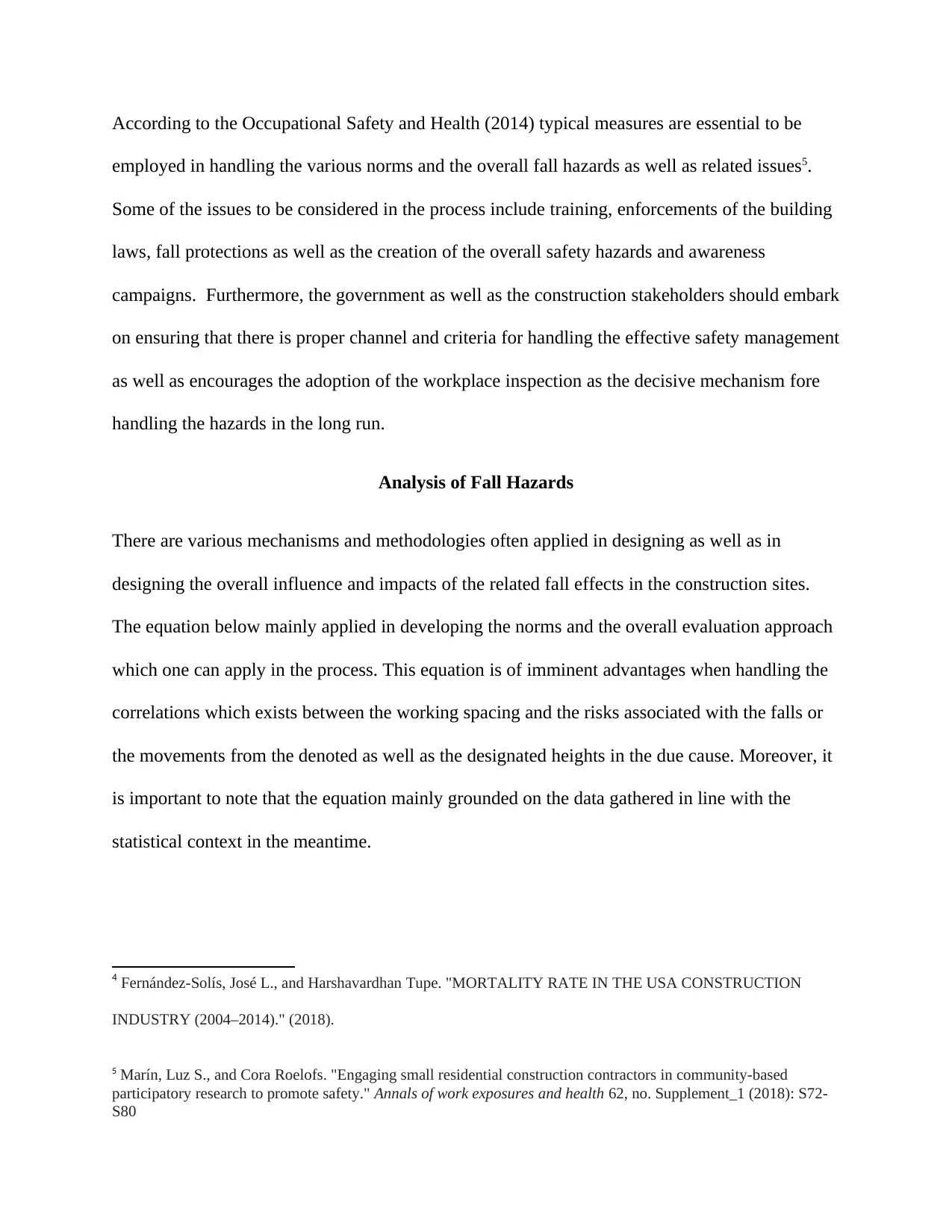
According to the Occupational Safety and Health (2014) typical measures are essential to be
employed in handling the various norms and the overall fall hazards as well as related issues5.
Some of the issues to be considered in the process include training, enforcements of the building
laws, fall protections as well as the creation of the overall safety hazards and awareness
campaigns. Furthermore, the government as well as the construction stakeholders should embark
on ensuring that there is proper channel and criteria for handling the effective safety management
as well as encourages the adoption of the workplace inspection as the decisive mechanism fore
handling the hazards in the long run.
Analysis of Fall Hazards
There are various mechanisms and methodologies often applied in designing as well as in
designing the overall influence and impacts of the related fall effects in the construction sites.
The equation below mainly applied in developing the norms and the overall evaluation approach
which one can apply in the process. This equation is of imminent advantages when handling the
correlations which exists between the working spacing and the risks associated with the falls or
the movements from the denoted as well as the designated heights in the due cause. Moreover, it
is important to note that the equation mainly grounded on the data gathered in line with the
statistical context in the meantime.
4 Fernández-Solís, José L., and Harshavardhan Tupe. "MORTALITY RATE IN THE USA CONSTRUCTION
INDUSTRY (2004–2014)." (2018).
5 Marín, Luz S., and Cora Roelofs. "Engaging small residential construction contractors in community-based
participatory research to promote safety." Annals of work exposures and health 62, no. Supplement_1 (2018): S72-
S80
employed in handling the various norms and the overall fall hazards as well as related issues5.
Some of the issues to be considered in the process include training, enforcements of the building
laws, fall protections as well as the creation of the overall safety hazards and awareness
campaigns. Furthermore, the government as well as the construction stakeholders should embark
on ensuring that there is proper channel and criteria for handling the effective safety management
as well as encourages the adoption of the workplace inspection as the decisive mechanism fore
handling the hazards in the long run.
Analysis of Fall Hazards
There are various mechanisms and methodologies often applied in designing as well as in
designing the overall influence and impacts of the related fall effects in the construction sites.
The equation below mainly applied in developing the norms and the overall evaluation approach
which one can apply in the process. This equation is of imminent advantages when handling the
correlations which exists between the working spacing and the risks associated with the falls or
the movements from the denoted as well as the designated heights in the due cause. Moreover, it
is important to note that the equation mainly grounded on the data gathered in line with the
statistical context in the meantime.
4 Fernández-Solís, José L., and Harshavardhan Tupe. "MORTALITY RATE IN THE USA CONSTRUCTION
INDUSTRY (2004–2014)." (2018).
5 Marín, Luz S., and Cora Roelofs. "Engaging small residential construction contractors in community-based
participatory research to promote safety." Annals of work exposures and health 62, no. Supplement_1 (2018): S72-
S80
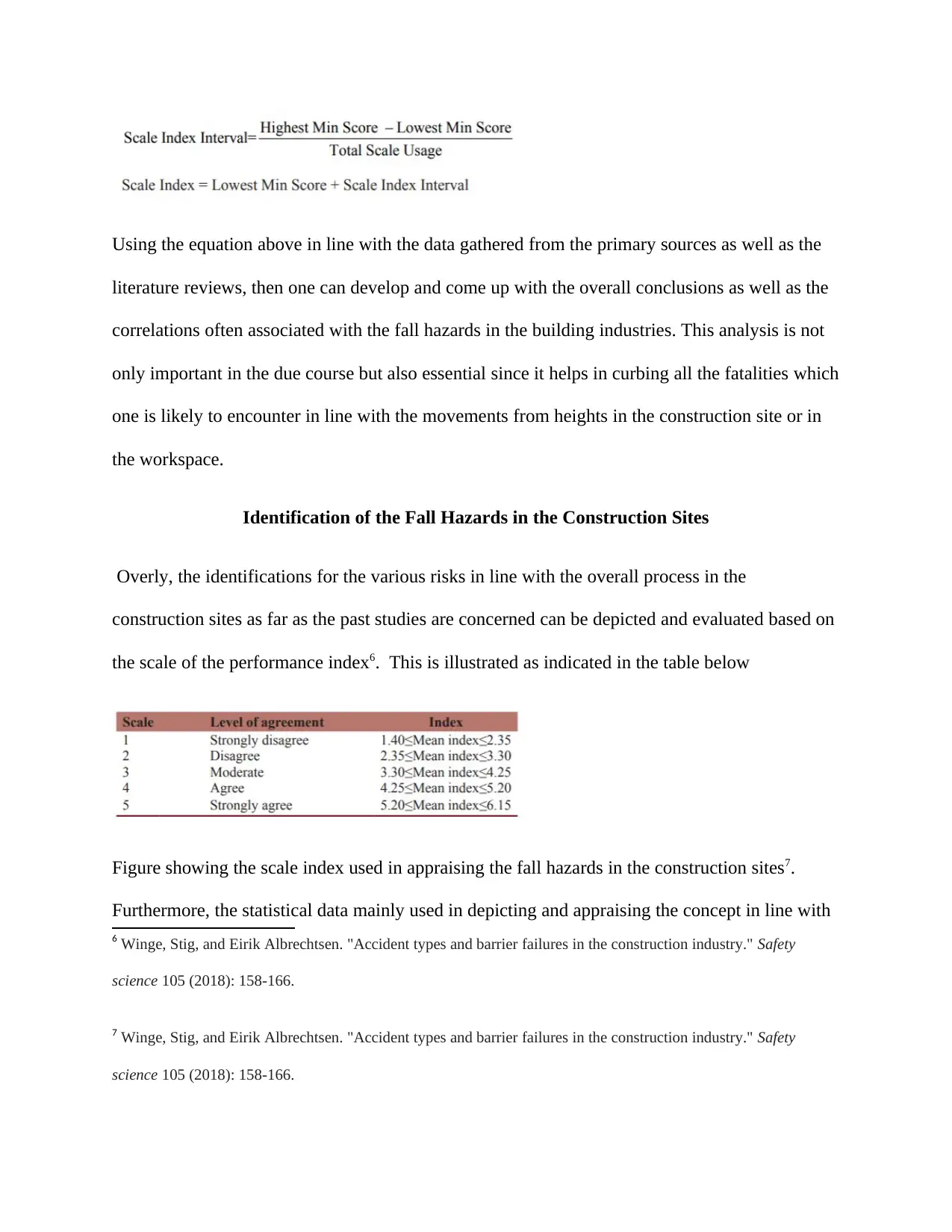
Using the equation above in line with the data gathered from the primary sources as well as the
literature reviews, then one can develop and come up with the overall conclusions as well as the
correlations often associated with the fall hazards in the building industries. This analysis is not
only important in the due course but also essential since it helps in curbing all the fatalities which
one is likely to encounter in line with the movements from heights in the construction site or in
the workspace.
Identification of the Fall Hazards in the Construction Sites
Overly, the identifications for the various risks in line with the overall process in the
construction sites as far as the past studies are concerned can be depicted and evaluated based on
the scale of the performance index6. This is illustrated as indicated in the table below
Figure showing the scale index used in appraising the fall hazards in the construction sites7.
Furthermore, the statistical data mainly used in depicting and appraising the concept in line with
6 Winge, Stig, and Eirik Albrechtsen. "Accident types and barrier failures in the construction industry." Safety
science 105 (2018): 158-166.
7 Winge, Stig, and Eirik Albrechtsen. "Accident types and barrier failures in the construction industry." Safety
science 105 (2018): 158-166.
literature reviews, then one can develop and come up with the overall conclusions as well as the
correlations often associated with the fall hazards in the building industries. This analysis is not
only important in the due course but also essential since it helps in curbing all the fatalities which
one is likely to encounter in line with the movements from heights in the construction site or in
the workspace.
Identification of the Fall Hazards in the Construction Sites
Overly, the identifications for the various risks in line with the overall process in the
construction sites as far as the past studies are concerned can be depicted and evaluated based on
the scale of the performance index6. This is illustrated as indicated in the table below
Figure showing the scale index used in appraising the fall hazards in the construction sites7.
Furthermore, the statistical data mainly used in depicting and appraising the concept in line with
6 Winge, Stig, and Eirik Albrechtsen. "Accident types and barrier failures in the construction industry." Safety
science 105 (2018): 158-166.
7 Winge, Stig, and Eirik Albrechtsen. "Accident types and barrier failures in the construction industry." Safety
science 105 (2018): 158-166.
Paraphrase This Document
Need a fresh take? Get an instant paraphrase of this document with our AI Paraphraser
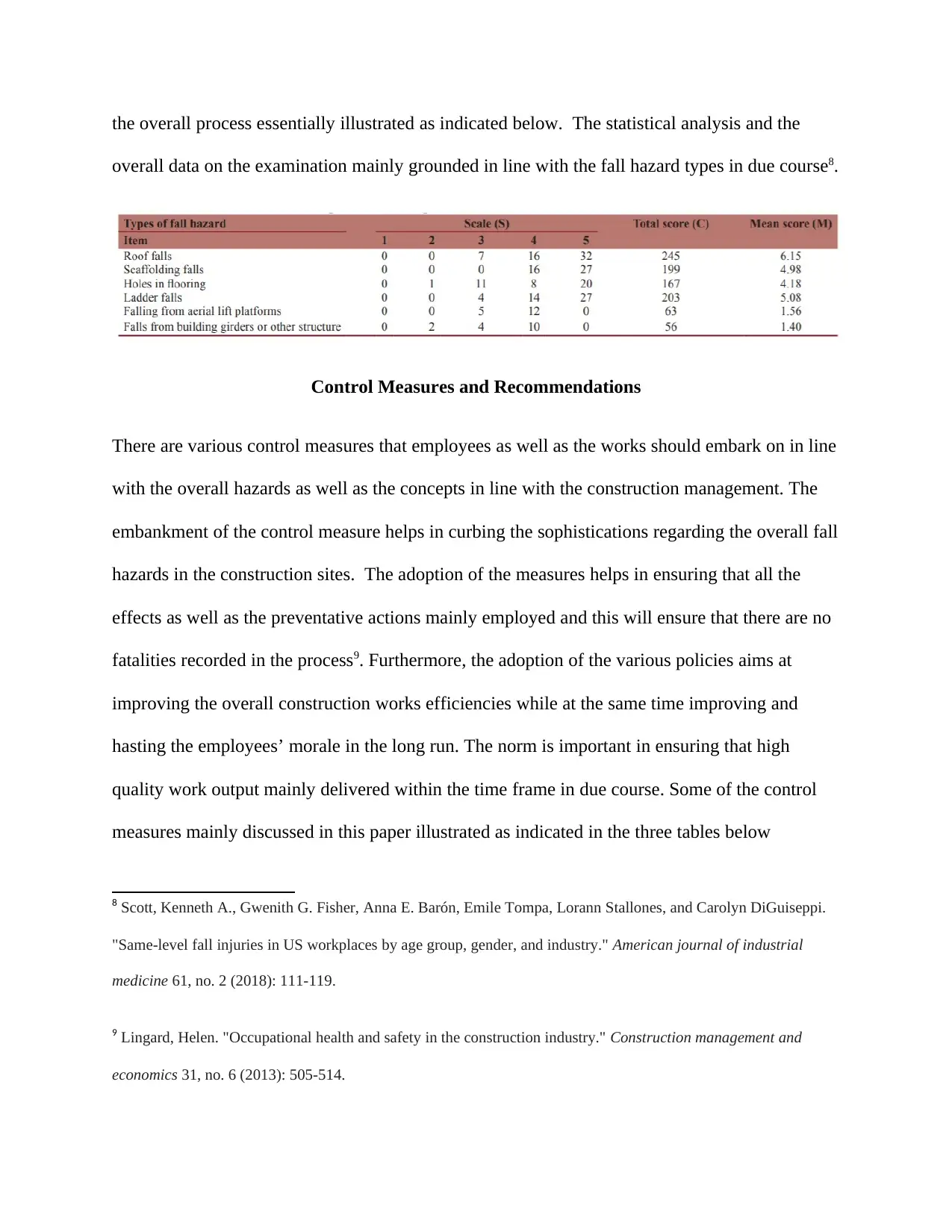
the overall process essentially illustrated as indicated below. The statistical analysis and the
overall data on the examination mainly grounded in line with the fall hazard types in due course8.
Control Measures and Recommendations
There are various control measures that employees as well as the works should embark on in line
with the overall hazards as well as the concepts in line with the construction management. The
embankment of the control measure helps in curbing the sophistications regarding the overall fall
hazards in the construction sites. The adoption of the measures helps in ensuring that all the
effects as well as the preventative actions mainly employed and this will ensure that there are no
fatalities recorded in the process9. Furthermore, the adoption of the various policies aims at
improving the overall construction works efficiencies while at the same time improving and
hasting the employees’ morale in the long run. The norm is important in ensuring that high
quality work output mainly delivered within the time frame in due course. Some of the control
measures mainly discussed in this paper illustrated as indicated in the three tables below
8 Scott, Kenneth A., Gwenith G. Fisher, Anna E. Barón, Emile Tompa, Lorann Stallones, and Carolyn DiGuiseppi.
"Same‐level fall injuries in US workplaces by age group, gender, and industry." American journal of industrial
medicine 61, no. 2 (2018): 111-119.
9 Lingard, Helen. "Occupational health and safety in the construction industry." Construction management and
economics 31, no. 6 (2013): 505-514.
overall data on the examination mainly grounded in line with the fall hazard types in due course8.
Control Measures and Recommendations
There are various control measures that employees as well as the works should embark on in line
with the overall hazards as well as the concepts in line with the construction management. The
embankment of the control measure helps in curbing the sophistications regarding the overall fall
hazards in the construction sites. The adoption of the measures helps in ensuring that all the
effects as well as the preventative actions mainly employed and this will ensure that there are no
fatalities recorded in the process9. Furthermore, the adoption of the various policies aims at
improving the overall construction works efficiencies while at the same time improving and
hasting the employees’ morale in the long run. The norm is important in ensuring that high
quality work output mainly delivered within the time frame in due course. Some of the control
measures mainly discussed in this paper illustrated as indicated in the three tables below
8 Scott, Kenneth A., Gwenith G. Fisher, Anna E. Barón, Emile Tompa, Lorann Stallones, and Carolyn DiGuiseppi.
"Same‐level fall injuries in US workplaces by age group, gender, and industry." American journal of industrial
medicine 61, no. 2 (2018): 111-119.
9 Lingard, Helen. "Occupational health and safety in the construction industry." Construction management and
economics 31, no. 6 (2013): 505-514.
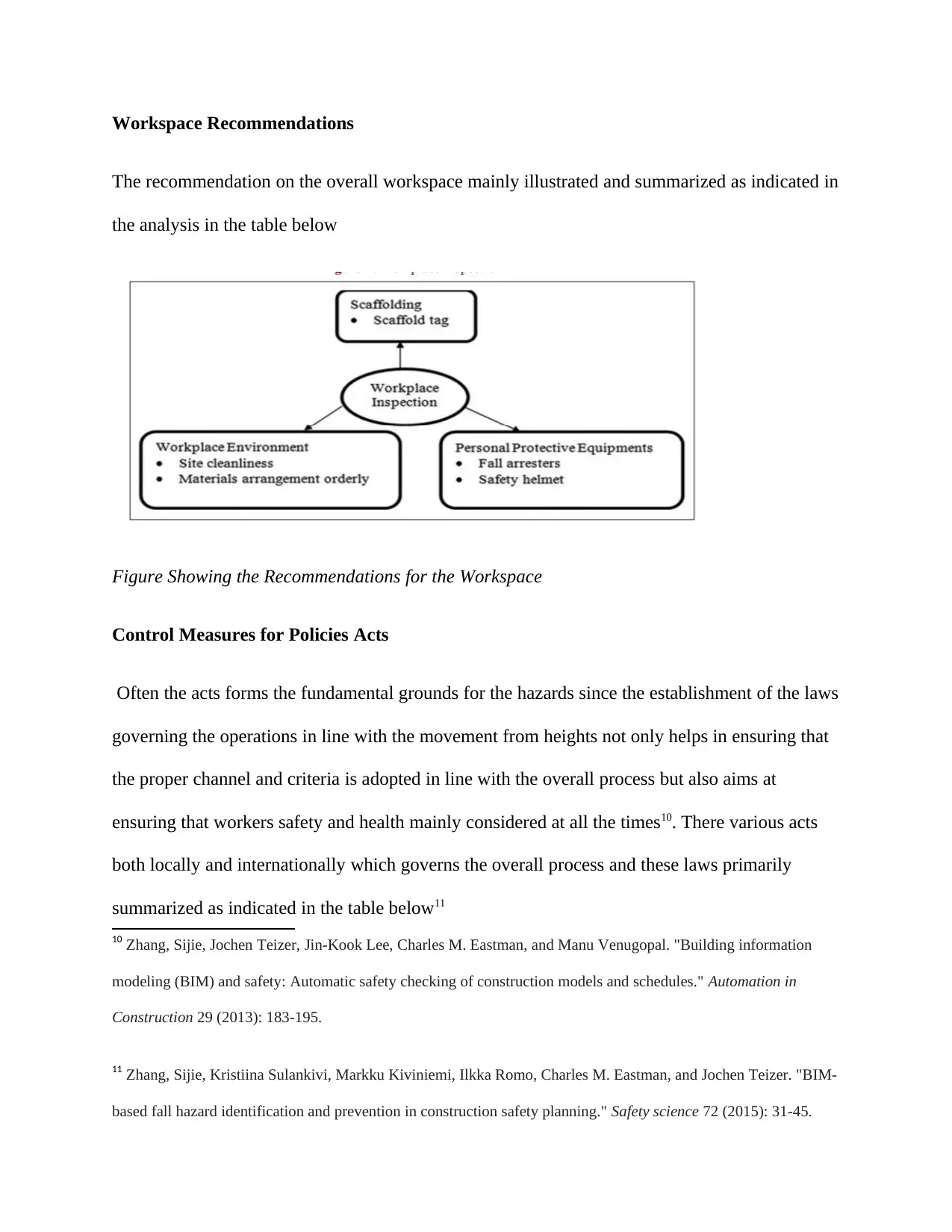
Workspace Recommendations
The recommendation on the overall workspace mainly illustrated and summarized as indicated in
the analysis in the table below
Figure Showing the Recommendations for the Workspace
Control Measures for Policies Acts
Often the acts forms the fundamental grounds for the hazards since the establishment of the laws
governing the operations in line with the movement from heights not only helps in ensuring that
the proper channel and criteria is adopted in line with the overall process but also aims at
ensuring that workers safety and health mainly considered at all the times10. There various acts
both locally and internationally which governs the overall process and these laws primarily
summarized as indicated in the table below11
10 Zhang, Sijie, Jochen Teizer, Jin-Kook Lee, Charles M. Eastman, and Manu Venugopal. "Building information
modeling (BIM) and safety: Automatic safety checking of construction models and schedules." Automation in
Construction 29 (2013): 183-195.
11 Zhang, Sijie, Kristiina Sulankivi, Markku Kiviniemi, Ilkka Romo, Charles M. Eastman, and Jochen Teizer. "BIM-
based fall hazard identification and prevention in construction safety planning." Safety science 72 (2015): 31-45.
The recommendation on the overall workspace mainly illustrated and summarized as indicated in
the analysis in the table below
Figure Showing the Recommendations for the Workspace
Control Measures for Policies Acts
Often the acts forms the fundamental grounds for the hazards since the establishment of the laws
governing the operations in line with the movement from heights not only helps in ensuring that
the proper channel and criteria is adopted in line with the overall process but also aims at
ensuring that workers safety and health mainly considered at all the times10. There various acts
both locally and internationally which governs the overall process and these laws primarily
summarized as indicated in the table below11
10 Zhang, Sijie, Jochen Teizer, Jin-Kook Lee, Charles M. Eastman, and Manu Venugopal. "Building information
modeling (BIM) and safety: Automatic safety checking of construction models and schedules." Automation in
Construction 29 (2013): 183-195.
11 Zhang, Sijie, Kristiina Sulankivi, Markku Kiviniemi, Ilkka Romo, Charles M. Eastman, and Jochen Teizer. "BIM-
based fall hazard identification and prevention in construction safety planning." Safety science 72 (2015): 31-45.
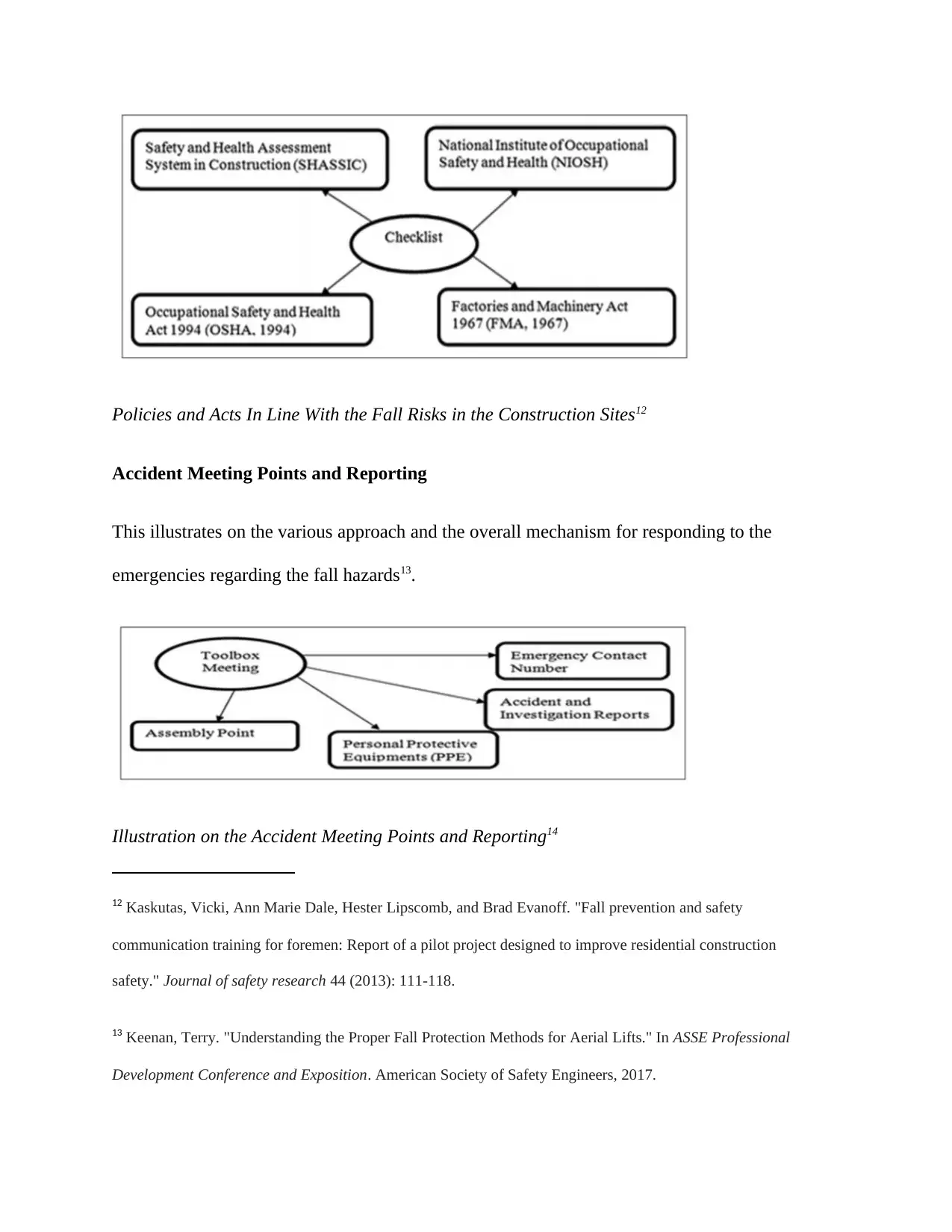
Policies and Acts In Line With the Fall Risks in the Construction Sites12
Accident Meeting Points and Reporting
This illustrates on the various approach and the overall mechanism for responding to the
emergencies regarding the fall hazards13.
Illustration on the Accident Meeting Points and Reporting14
12 Kaskutas, Vicki, Ann Marie Dale, Hester Lipscomb, and Brad Evanoff. "Fall prevention and safety
communication training for foremen: Report of a pilot project designed to improve residential construction
safety." Journal of safety research 44 (2013): 111-118.
13 Keenan, Terry. "Understanding the Proper Fall Protection Methods for Aerial Lifts." In ASSE Professional
Development Conference and Exposition. American Society of Safety Engineers, 2017.
Accident Meeting Points and Reporting
This illustrates on the various approach and the overall mechanism for responding to the
emergencies regarding the fall hazards13.
Illustration on the Accident Meeting Points and Reporting14
12 Kaskutas, Vicki, Ann Marie Dale, Hester Lipscomb, and Brad Evanoff. "Fall prevention and safety
communication training for foremen: Report of a pilot project designed to improve residential construction
safety." Journal of safety research 44 (2013): 111-118.
13 Keenan, Terry. "Understanding the Proper Fall Protection Methods for Aerial Lifts." In ASSE Professional
Development Conference and Exposition. American Society of Safety Engineers, 2017.
Secure Best Marks with AI Grader
Need help grading? Try our AI Grader for instant feedback on your assignments.
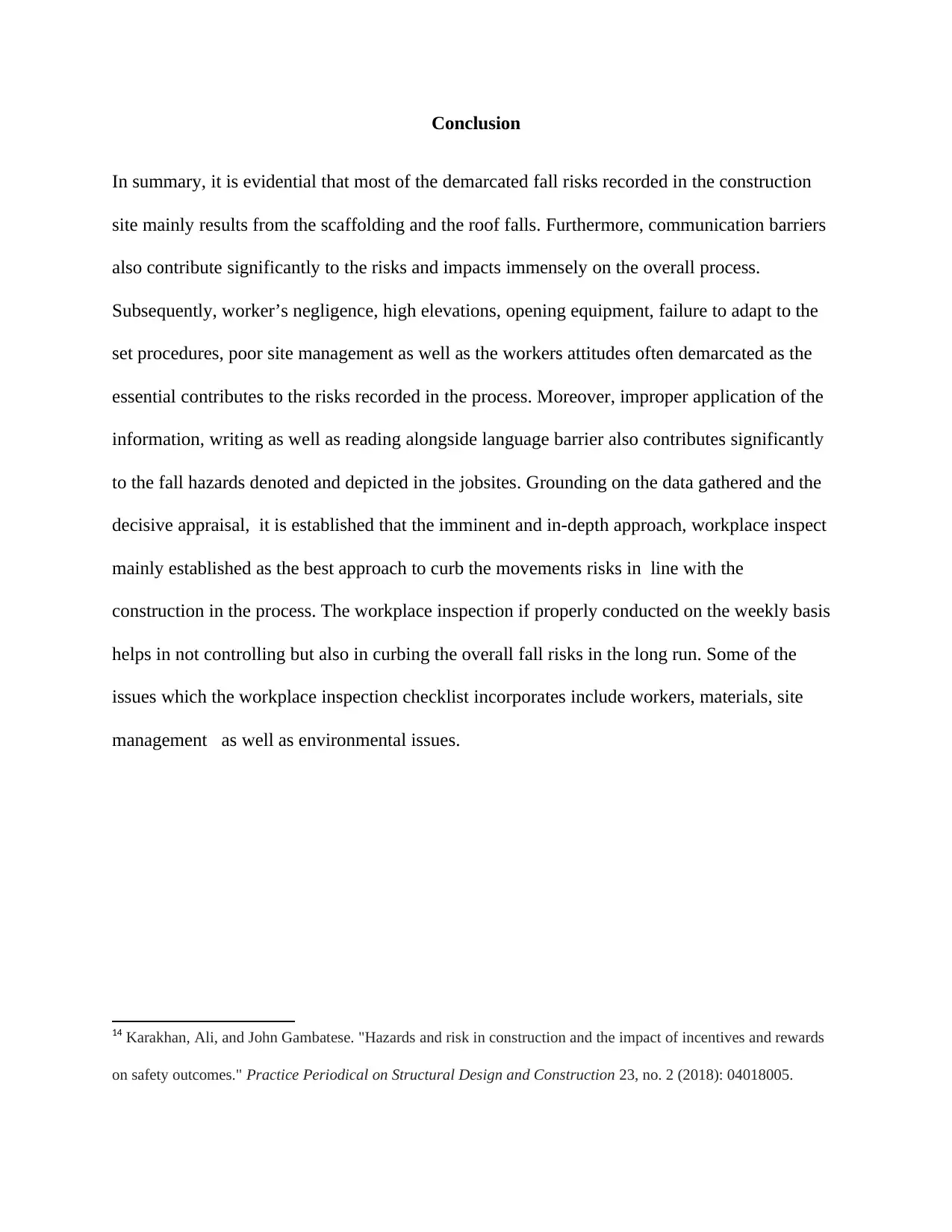
Conclusion
In summary, it is evidential that most of the demarcated fall risks recorded in the construction
site mainly results from the scaffolding and the roof falls. Furthermore, communication barriers
also contribute significantly to the risks and impacts immensely on the overall process.
Subsequently, worker’s negligence, high elevations, opening equipment, failure to adapt to the
set procedures, poor site management as well as the workers attitudes often demarcated as the
essential contributes to the risks recorded in the process. Moreover, improper application of the
information, writing as well as reading alongside language barrier also contributes significantly
to the fall hazards denoted and depicted in the jobsites. Grounding on the data gathered and the
decisive appraisal, it is established that the imminent and in-depth approach, workplace inspect
mainly established as the best approach to curb the movements risks in line with the
construction in the process. The workplace inspection if properly conducted on the weekly basis
helps in not controlling but also in curbing the overall fall risks in the long run. Some of the
issues which the workplace inspection checklist incorporates include workers, materials, site
management as well as environmental issues.
14 Karakhan, Ali, and John Gambatese. "Hazards and risk in construction and the impact of incentives and rewards
on safety outcomes." Practice Periodical on Structural Design and Construction 23, no. 2 (2018): 04018005.
In summary, it is evidential that most of the demarcated fall risks recorded in the construction
site mainly results from the scaffolding and the roof falls. Furthermore, communication barriers
also contribute significantly to the risks and impacts immensely on the overall process.
Subsequently, worker’s negligence, high elevations, opening equipment, failure to adapt to the
set procedures, poor site management as well as the workers attitudes often demarcated as the
essential contributes to the risks recorded in the process. Moreover, improper application of the
information, writing as well as reading alongside language barrier also contributes significantly
to the fall hazards denoted and depicted in the jobsites. Grounding on the data gathered and the
decisive appraisal, it is established that the imminent and in-depth approach, workplace inspect
mainly established as the best approach to curb the movements risks in line with the
construction in the process. The workplace inspection if properly conducted on the weekly basis
helps in not controlling but also in curbing the overall fall risks in the long run. Some of the
issues which the workplace inspection checklist incorporates include workers, materials, site
management as well as environmental issues.
14 Karakhan, Ali, and John Gambatese. "Hazards and risk in construction and the impact of incentives and rewards
on safety outcomes." Practice Periodical on Structural Design and Construction 23, no. 2 (2018): 04018005.
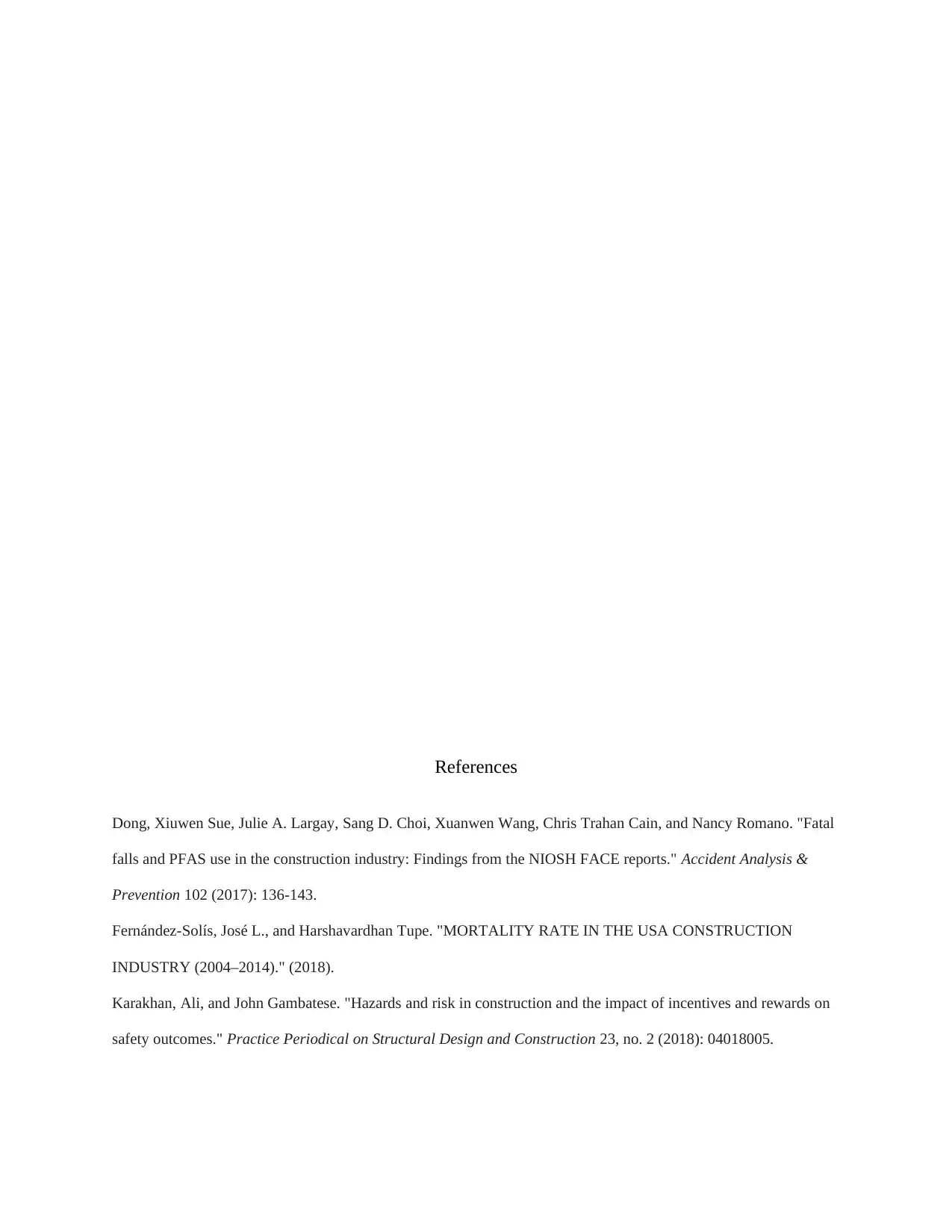
References
Dong, Xiuwen Sue, Julie A. Largay, Sang D. Choi, Xuanwen Wang, Chris Trahan Cain, and Nancy Romano. "Fatal
falls and PFAS use in the construction industry: Findings from the NIOSH FACE reports." Accident Analysis &
Prevention 102 (2017): 136-143.
Fernández-Solís, José L., and Harshavardhan Tupe. "MORTALITY RATE IN THE USA CONSTRUCTION
INDUSTRY (2004–2014)." (2018).
Karakhan, Ali, and John Gambatese. "Hazards and risk in construction and the impact of incentives and rewards on
safety outcomes." Practice Periodical on Structural Design and Construction 23, no. 2 (2018): 04018005.
Dong, Xiuwen Sue, Julie A. Largay, Sang D. Choi, Xuanwen Wang, Chris Trahan Cain, and Nancy Romano. "Fatal
falls and PFAS use in the construction industry: Findings from the NIOSH FACE reports." Accident Analysis &
Prevention 102 (2017): 136-143.
Fernández-Solís, José L., and Harshavardhan Tupe. "MORTALITY RATE IN THE USA CONSTRUCTION
INDUSTRY (2004–2014)." (2018).
Karakhan, Ali, and John Gambatese. "Hazards and risk in construction and the impact of incentives and rewards on
safety outcomes." Practice Periodical on Structural Design and Construction 23, no. 2 (2018): 04018005.
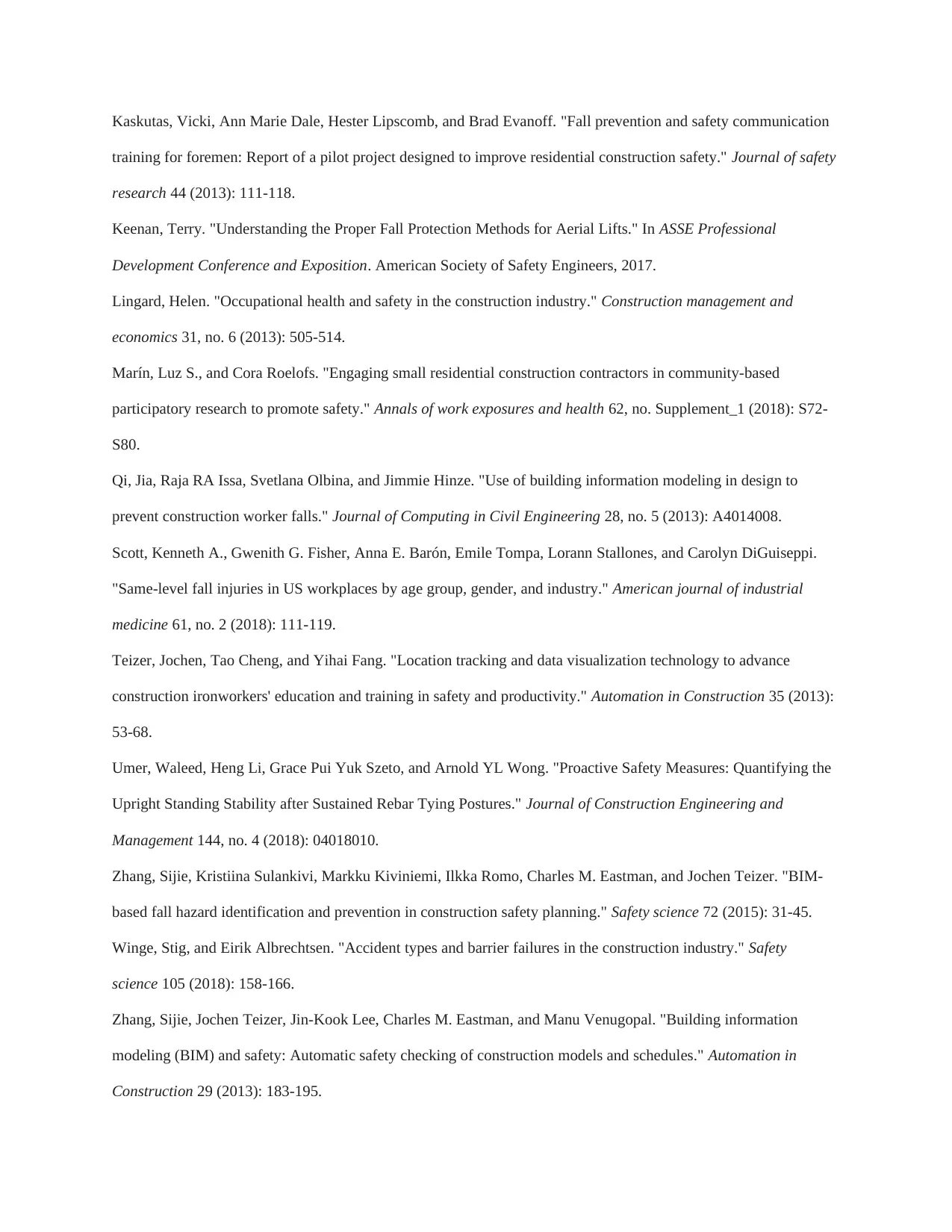
Kaskutas, Vicki, Ann Marie Dale, Hester Lipscomb, and Brad Evanoff. "Fall prevention and safety communication
training for foremen: Report of a pilot project designed to improve residential construction safety." Journal of safety
research 44 (2013): 111-118.
Keenan, Terry. "Understanding the Proper Fall Protection Methods for Aerial Lifts." In ASSE Professional
Development Conference and Exposition. American Society of Safety Engineers, 2017.
Lingard, Helen. "Occupational health and safety in the construction industry." Construction management and
economics 31, no. 6 (2013): 505-514.
Marín, Luz S., and Cora Roelofs. "Engaging small residential construction contractors in community-based
participatory research to promote safety." Annals of work exposures and health 62, no. Supplement_1 (2018): S72-
S80.
Qi, Jia, Raja RA Issa, Svetlana Olbina, and Jimmie Hinze. "Use of building information modeling in design to
prevent construction worker falls." Journal of Computing in Civil Engineering 28, no. 5 (2013): A4014008.
Scott, Kenneth A., Gwenith G. Fisher, Anna E. Barón, Emile Tompa, Lorann Stallones, and Carolyn DiGuiseppi.
"Same‐level fall injuries in US workplaces by age group, gender, and industry." American journal of industrial
medicine 61, no. 2 (2018): 111-119.
Teizer, Jochen, Tao Cheng, and Yihai Fang. "Location tracking and data visualization technology to advance
construction ironworkers' education and training in safety and productivity." Automation in Construction 35 (2013):
53-68.
Umer, Waleed, Heng Li, Grace Pui Yuk Szeto, and Arnold YL Wong. "Proactive Safety Measures: Quantifying the
Upright Standing Stability after Sustained Rebar Tying Postures." Journal of Construction Engineering and
Management 144, no. 4 (2018): 04018010.
Zhang, Sijie, Kristiina Sulankivi, Markku Kiviniemi, Ilkka Romo, Charles M. Eastman, and Jochen Teizer. "BIM-
based fall hazard identification and prevention in construction safety planning." Safety science 72 (2015): 31-45.
Winge, Stig, and Eirik Albrechtsen. "Accident types and barrier failures in the construction industry." Safety
science 105 (2018): 158-166.
Zhang, Sijie, Jochen Teizer, Jin-Kook Lee, Charles M. Eastman, and Manu Venugopal. "Building information
modeling (BIM) and safety: Automatic safety checking of construction models and schedules." Automation in
Construction 29 (2013): 183-195.
training for foremen: Report of a pilot project designed to improve residential construction safety." Journal of safety
research 44 (2013): 111-118.
Keenan, Terry. "Understanding the Proper Fall Protection Methods for Aerial Lifts." In ASSE Professional
Development Conference and Exposition. American Society of Safety Engineers, 2017.
Lingard, Helen. "Occupational health and safety in the construction industry." Construction management and
economics 31, no. 6 (2013): 505-514.
Marín, Luz S., and Cora Roelofs. "Engaging small residential construction contractors in community-based
participatory research to promote safety." Annals of work exposures and health 62, no. Supplement_1 (2018): S72-
S80.
Qi, Jia, Raja RA Issa, Svetlana Olbina, and Jimmie Hinze. "Use of building information modeling in design to
prevent construction worker falls." Journal of Computing in Civil Engineering 28, no. 5 (2013): A4014008.
Scott, Kenneth A., Gwenith G. Fisher, Anna E. Barón, Emile Tompa, Lorann Stallones, and Carolyn DiGuiseppi.
"Same‐level fall injuries in US workplaces by age group, gender, and industry." American journal of industrial
medicine 61, no. 2 (2018): 111-119.
Teizer, Jochen, Tao Cheng, and Yihai Fang. "Location tracking and data visualization technology to advance
construction ironworkers' education and training in safety and productivity." Automation in Construction 35 (2013):
53-68.
Umer, Waleed, Heng Li, Grace Pui Yuk Szeto, and Arnold YL Wong. "Proactive Safety Measures: Quantifying the
Upright Standing Stability after Sustained Rebar Tying Postures." Journal of Construction Engineering and
Management 144, no. 4 (2018): 04018010.
Zhang, Sijie, Kristiina Sulankivi, Markku Kiviniemi, Ilkka Romo, Charles M. Eastman, and Jochen Teizer. "BIM-
based fall hazard identification and prevention in construction safety planning." Safety science 72 (2015): 31-45.
Winge, Stig, and Eirik Albrechtsen. "Accident types and barrier failures in the construction industry." Safety
science 105 (2018): 158-166.
Zhang, Sijie, Jochen Teizer, Jin-Kook Lee, Charles M. Eastman, and Manu Venugopal. "Building information
modeling (BIM) and safety: Automatic safety checking of construction models and schedules." Automation in
Construction 29 (2013): 183-195.
1 out of 13
Your All-in-One AI-Powered Toolkit for Academic Success.
+13062052269
info@desklib.com
Available 24*7 on WhatsApp / Email
![[object Object]](/_next/static/media/star-bottom.7253800d.svg)
Unlock your academic potential
© 2024 | Zucol Services PVT LTD | All rights reserved.





